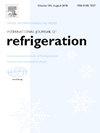Thermodynamic assessment and optimization of a solar and diesel engine exhaust-driven ORC-VCR system
IF 3.5
2区 工程技术
Q1 ENGINEERING, MECHANICAL
International Journal of Refrigeration-revue Internationale Du Froid
Pub Date : 2025-02-01
DOI:10.1016/j.ijrefrig.2024.11.035
引用次数: 0
Abstract
Waste heat recovery is characterized as an appealing method to enhance overall energy efficiency. Therefore, in this paper, the Vapor Compression Refrigeration (VCR) system employs the diesel engine exhaust-powered Organic Rankine cycle (ORC) to generate the cooling effect. The ORC is further modified in order to generate additional power using solar energy. The source temperatures of diesel engine exhaust and solar heat are taken in the range of 690–810 K and 433–473 K, respectively. The thermodynamic investigation consists of an energy and exergy analysis to determine the effect of turbine inlet temperatures, condenser temperature, and evaporator temperature over the performance parameters of the ORC-VCR system. The study exhibits the coefficient of performance (COP) of the system for the Benzene-R601 refrigerant pair is maximum which is 1.18. The exergetic efficiency for the same refrigerant pair is 18 % more as compared to Cyclohexane-R1234yf refrigerant pair. A multi-objective optimization procedure was executed utilizing a genetic algorithm (GA), which suggested that at the temperature of the higher-pressure turbine is 548.33 K and the temperature of the lower-pressure turbine is 439.19 K, which delivered the maximum cooling effect i.e. of 33.72 TR. Moreover, the system exhibits better COP and cooling capacity at lower ambient temperatures.
太阳能和柴油发动机排气驱动ORC-VCR系统的热力学评估与优化
废热回收的特点是一个有吸引力的方法,以提高整体能源效率。因此,在本文中,蒸汽压缩制冷(VCR)系统采用柴油机排气驱动的有机朗肯循环(ORC)来产生冷却效果。ORC被进一步修改,以便利用太阳能产生额外的电力。柴油机排气源温度为690 ~ 810 K,太阳能源温度为433 ~ 473 K。热力学研究包括能量和火用分析,以确定涡轮入口温度、冷凝器温度和蒸发器温度对ORC-VCR系统性能参数的影响。研究表明,苯- r601制冷剂对系统的性能系数(COP)最大,为1.18。与环己烷- r1234yf制冷剂对相比,同一制冷剂对的火用效率提高18%。采用遗传算法(GA)进行多目标优化,结果表明,高压涡轮温度为548.33 K,低压涡轮温度为439.19 K时,系统的冷却效果最大,为33.72 TR,且系统在较低环境温度下具有较好的COP和冷却能力。
本文章由计算机程序翻译,如有差异,请以英文原文为准。
求助全文
约1分钟内获得全文
求助全文
来源期刊
CiteScore
7.30
自引率
12.80%
发文量
363
审稿时长
3.7 months
期刊介绍:
The International Journal of Refrigeration is published for the International Institute of Refrigeration (IIR) by Elsevier. It is essential reading for all those wishing to keep abreast of research and industrial news in refrigeration, air conditioning and associated fields. This is particularly important in these times of rapid introduction of alternative refrigerants and the emergence of new technology. The journal has published special issues on alternative refrigerants and novel topics in the field of boiling, condensation, heat pumps, food refrigeration, carbon dioxide, ammonia, hydrocarbons, magnetic refrigeration at room temperature, sorptive cooling, phase change materials and slurries, ejector technology, compressors, and solar cooling.
As well as original research papers the International Journal of Refrigeration also includes review articles, papers presented at IIR conferences, short reports and letters describing preliminary results and experimental details, and letters to the Editor on recent areas of discussion and controversy. Other features include forthcoming events, conference reports and book reviews.
Papers are published in either English or French with the IIR news section in both languages.

 求助内容:
求助内容: 应助结果提醒方式:
应助结果提醒方式:


